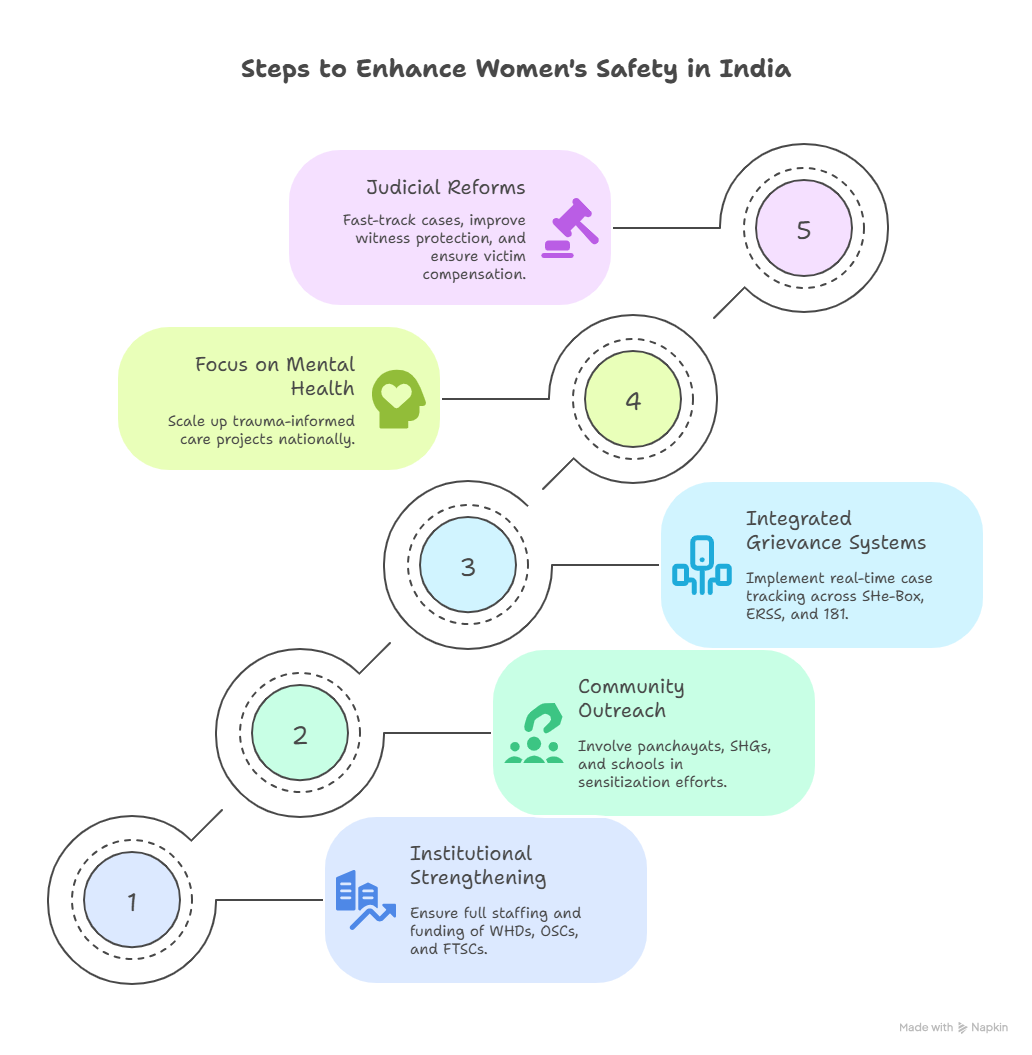India’s Commitment to Women’s Safety: Urgent Action Needed Amid Rising Crimes
In Odisha, crimes against women mount as courts and police falter
Context: Odisha has witnessed a spate of brutal crimes against women in recent months, including cases of abduction, self-immolation, and suicide due to alleged institutional neglect. Coupled with a low conviction rate and the fourth highest number of pending court cases (2017–2022), the State’s response to women’s safety remains deeply inadequate.
What is the current status of women’s safety in India?
-
- Despite progress in legal rights and representation, India continues to witness significant crimes against women. As per the NCRB 2022 report, a total of 4,45,256 cases of crimes against women were registered, reflecting a Crime Rate of 66.4 per lakh women population. The most reported crimes include:
- Cruelty by husband/relatives (31.4%)
- Assault on women with intent to outrage modesty (20.8%)
- Kidnapping and abduction (17.6%)
- Rape (7.1%)
States like Uttar Pradesh, Rajasthan, and Maharashtra reported the highest numbers. These trends highlight the continued need for institutional, legal, and psychosocial interventions.
Why do major crimes against women persist in India?
- Patriarchal Mindsets: Deep-rooted gender norms result in control, subjugation, and normalisation of violence against women.
- Weak Enforcement and Delayed Justice: Low conviction rates (under 30% in many categories, per NCRB), poor investigation, and long trial periods embolden offenders.
- Economic Dependency & Lack of Support: Women with little economic autonomy often refrain from reporting abuse due to fear of retaliation or lack of rehabilitation support.
- Social Stigma: Survivors of sexual violence or trafficking face ostracisation, victim-blaming, and limited social reintegration pathways.
What are India’s Financial and Institutional Initiatives for Women’s Safety
-
The Nirbhaya Fund (2013–Present)
-
-
- The Nirbhaya Fund was launched in 2013 following the brutal Delhi gang rape case of December 2012. This centrally administered fund is aimed at supporting projects to enhance the safety and security of women in public and private spaces.
- As of FY2024–25, 76% of the total allocation—has been utilised for approved schemes.
-
-
Some of the key initiatives financed through the Nirbhaya Fund include:
-
- Establishment of One Stop Centres (OSCs) for comprehensive support to women facing violence.
- Launch and operation of the 181 Women Helpline, a dedicated emergency response line.
- Implementation of the Emergency Response Support System (ERSS-112), which integrates police, fire, ambulance, and women-specific helplines.
- Development of Safe City Projects in major urban centres to enhance women’s safety in public spaces.
- Strengthening of Anti-Human Trafficking Units (AHTUs).
- Setting up of Cyber Forensic Labs to address digital crimes against women.
- Introduction of safety measures in rail and road transport systems to secure commuting women.
- Major Government Schemes and Support Mechanisms
- SHe-Box (Sexual Harassment Electronic Box): The SHe-Box portal serves as a single-window complaint mechanism for women facing sexual harassment at the workplace.The portal is maintained by the MWCD and is open to both public and private sector employees.
- Women Help Desks (WHDs) in Police Stations: To improve women’s accessibility to law enforcement, Women Help Desks have been established in 14,658 police stations, out of which 13,743 are headed by female police officers. These desks help ensure that women feel safe while reporting crimes and can access justice in a gender-sensitive environment.
What are the Legal Frameworks Ensuring Women’s Safety and Justice
- Bharatiya Nyaya Sanhita (BNS), 2023: The BNS 2023 introduces stricter punishments, including the death penalty for child rape, and enables the setup of Fast Track Special Courts (FTSCs) and exclusive POCSO courts to ensure speedy trials in sexual offence cases.
- Protection of Women from Domestic Violence Act (PWDVA), 2005: PWDVA provides protection against physical, sexual, emotional, and economic abuse. NFHS-5 (2019–21) shows a decline in spousal violence to 29.3%, reflecting gradual progress in enforcement and awareness.
- Dowry Prohibition Act, 1961: This law criminalises demand and exchange of dowry. Dowry-related deaths and harassment are also punishable under BNS 2023 and PWDVA, reinforcing the legal safeguards against dowry violence.
- Immoral Traffic (Prevention) Act, 1956: The Act addresses trafficking and commercial sexual exploitation, empowering authorities to act against traffickers and establish protective/corrective homes for victims.
- Prohibition of Child Marriage Act, 2006: This Act aims to eliminate child marriage, appoints Child Marriage Prohibition Officers (CMPOs), and mandates awareness and legal action to dismantle the practice at the community level.
- Sexual Harassment at Workplace Act, 2013 (POSH Act): POSH mandates formation of Internal Committees (ICs) in workplaces with over 10 employees to address complaints. The SHe-Box portal offers a unified platform for online complaints and monitoring.

How does the government address the psychological well-being of women facing violence?
- Project Stree Manoraksha: Mental Health Support for Survivors
-
-
- Launched by NIMHANS and the MWCD, Project Stree Manoraksha offers trauma-informed, culturally sensitive mental health care to women facing gender-based violence.
- It ensures holistic recovery by training OSCs staff, paralegals, administrators, and first responders for empathetic, professional support beyond legal or physical aid.
-
- Ujjawala Scheme: Rehabilitation of Trafficked Women
-
- The Ujjawala Scheme (since 2007) addresses the prevention, rescue, rehabilitation, and reintegration of trafficked women and children.
Implemented by NGOs, it provides immediate shelter, food, trauma care, and long-term support like vocational training and financial aid. Funded in a 90:10 ratio (GoI:NGO), it utilised ₹56.02 lakh of ₹66.07 lakh released (2010–15), indicating targeted psychosocial support.
